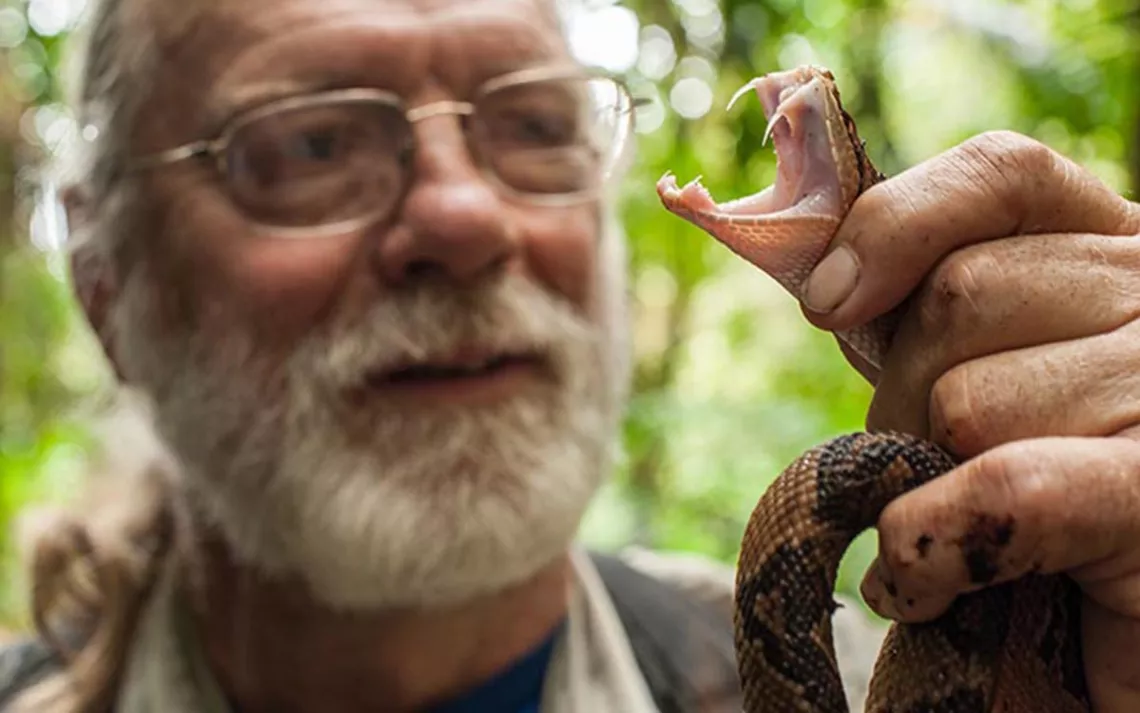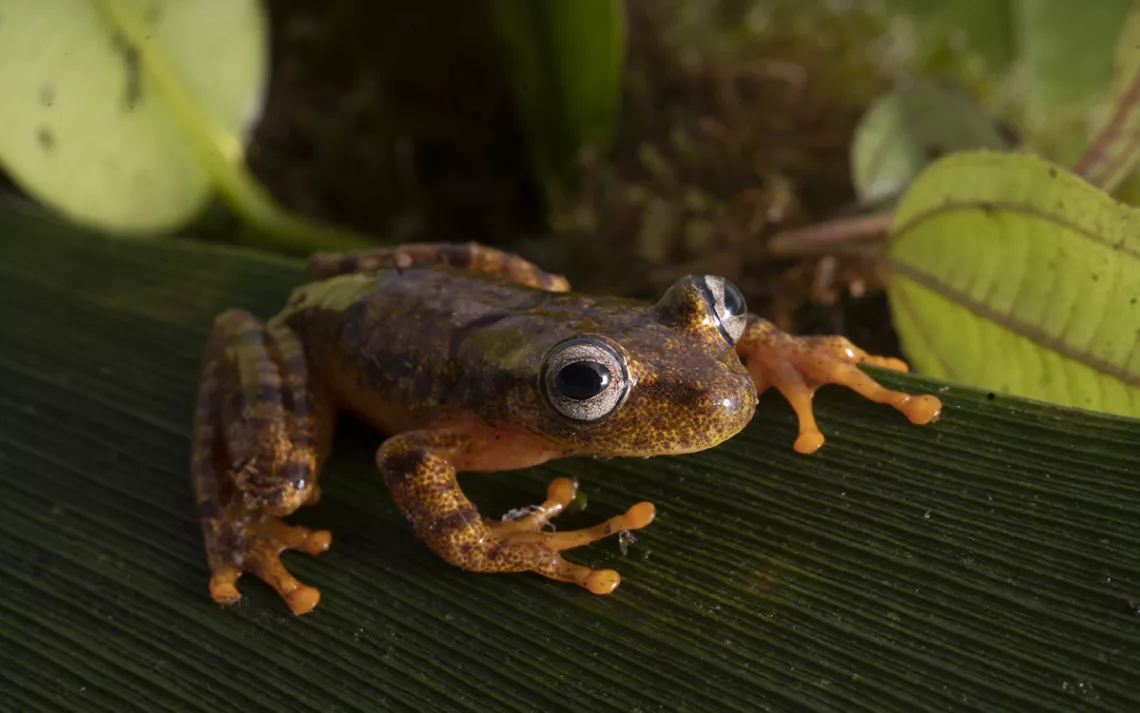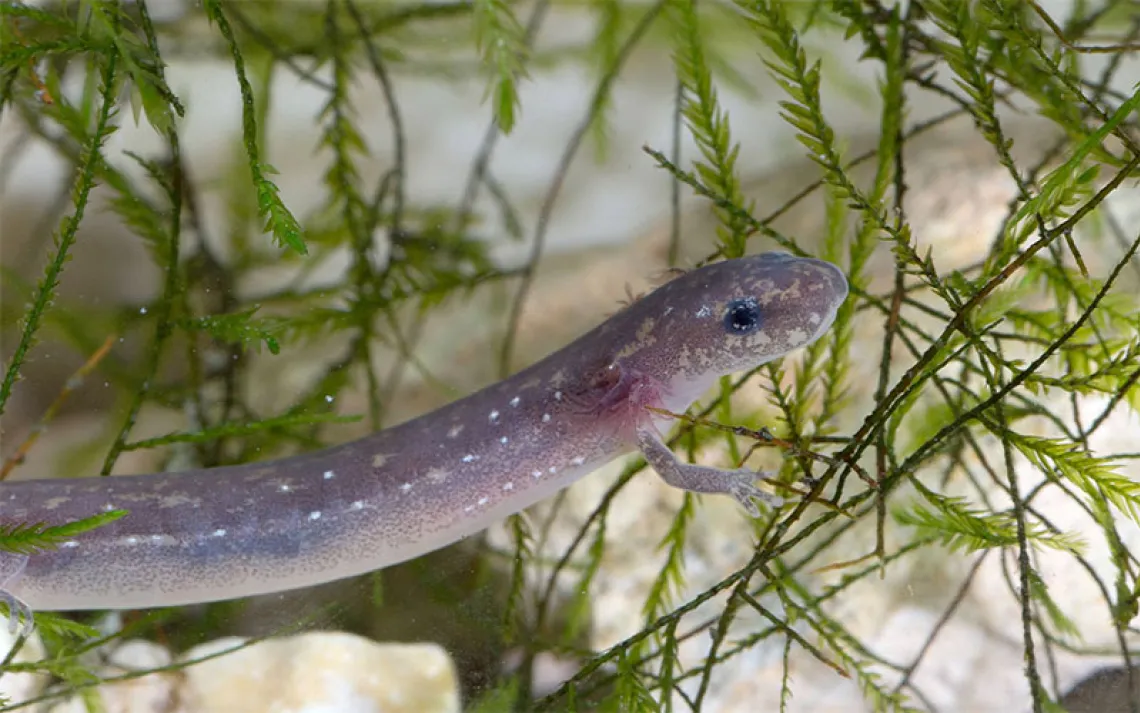Hunting Frogs on Islands in the Sky
Bruce Means is still looking for new species in Guyana and Venezuela while exploring the “Lost World Hypothesis”
For 81-year-old conservation biologist Bruce Means, the highlight of his life came in a dark, wet jungle on the summit of a remote tabletop mountain in Guyana in 2007. Alone in the dead of night—army-crawling over slimy tree roots as raindrops pattered all around—Means lifted up a leaf and saw an inch-and-a-half-long mottled green frog.
“I recognized it as a new little species pretty quickly,” Means said from his dry, book-lined office in Tallahassee, Florida.
A colleague’s DNA analysis later revealed that it wasn’t just a new species. Neither was it just a new genus. It was an entirely new family of frogs: the Ceuthomantidae family (from the Greek keuthos, or “hidden,” and mantis, or “treefrog”).
“Discovering a new family is almost unheard of,” Means said. “For a biologist, that’s a dream.” (Means’s frog was actually the second specimen of the second species within this new family—the first species was found in 1997—but the family was confirmed only through an analysis of Means’s sample.)
The discovery is just one moment in a long career of research among the flat-topped mountains of Guyana and Venezuela. Means has gone on 33 expeditions there, dating back to 1987. His most recent, in 2021, is the subject of the National Geographic documentary Explorer: The Last Tepui, which premiered in April. Throughout all his South American adventures looking for new species—he has discovered frogs, crabs, salamanders, and even a four-foot-long earthworm as big around as a garden hose—Means’s overarching goal is to zero in on the truth of the “Lost World Hypothesis.”
“The summits of tepuis are kind of like islands in the sky,” Means said, by way of explaining the hypothesis. Whereas the Galápagos Islands, also famous for their diverse biota, were never connected (animals arrived on each by air and wave dispersal), the tepuis, which are remnants of an eroded sedimentary highland, were connected. According to the Lost World Hypothesis, 70 million years ago, as the tepuis developed into distinct mesas separated from the lowlands by cliffs, animals and plants that lived on a once-continuous landscape became isolated and evolved separately.
“It makes for a really wonderful natural laboratory for evolution and ecological studies,” Means said. The Lost World Hypothesis has taken some hits in recent years after researchers determined that certain species of tree frog on different tepuis had a common ancestor only 5.3 million years in the past—much more recent than 70 million. Yet studies on individual toad species, for example, suggest they have been atop the tepuis for far longer, and scientists like Means continue to search for missing links in other evolutionary trees to help settle the theory. “You can’t understand nature and evolution if you don’t know its building blocks,” he said.
And he’s found a lot of blocks. “Bruce’s main contribution, I think, is the collection of specimens and tissue samples from remote areas,” said Philippe Kok, a biologist at the University of Łódź and the lead author on a number of articles to which Means has contributed. “The specimen of Ceuthomantis is certainly a great contribution. He is also extremely good—much better than me, for instance—at taking loads of notes about the natural history of the species he observes in the field. His notebooks are nothing else than impressive.”
Means remains as passionate about the jungle as ever and isn’t slowing down. On last year’s National Geographic–sponsored Guyana expedition, he teamed up with professional rock climbers Alex Honnold and Mark Synnott to try to reach the top of a tepui called Wei-Assipu.
Honnold, famous for climbing Yosemite’s El Capitan without a rope, sat next to Means during a full-day canoe ride. “He was narrating the jungle the whole time,” Honnold said. “I just saw the jungle as this impenetrable mass of vegetation, but he saw it as this rich tapestry of life.”
While trekking toward Wei-Assipu, Means collected samples and conducted a partial altitudinal transect of the jungle, recording the plants and animals that exist at different altitudes. When they reached the base of the tepui, the climbers made the first known ascent of the 1,000-foot walls. Means didn’t make it to the top though. He and the rest of the expedition members deemed it too dangerous for him, as he was on a blood thinner.
“If I got cut badly or broke a bone, I could have bled out,” he recalled. “So I could have endangered the whole expedition by getting hurt.”
But that doesn’t mean the expedition wasn’t a success for Means. He believes, though is not yet certain, that he discovered three frogs, one lizard, and one snake new to science. That would take the total number of new species he’s found to 24. Philippe Kok is quick to point out that, no matter how many species a scientist like Means or he “discovers”—Kok’s personal tally is 38—it pales in comparison to “how many new species Indigenous people found” first.
Nor does Means’s decision to forgo the summit mean that he’s scared of getting a little banged up—even at 81. “He was remarkable,” recalled Honnold. “We were trekking through this really rugged terrain for weeks. He took so many hard falls and tumbles into creeks.”
Such “occupational hazards,” as Means calls them, have been part of his work going back decades. Early in his career, from 1976 to 1984, Means’s research concentrated on the eastern diamondback rattlesnake—the world’s largest rattlesnake and North America’s most venomous snake. Once, while he was working by himself with a diamondback on an island off the shore of Panama City, Florida, the snake bit him. Means knew he was in trouble. He managed to get himself to his kayak, cross the bay, and go to a hospital, where he received antivenom that saved his life.
This dedication to his craft made Means “probably the world’s foremost authority on diamondback rattlesnakes” for a time, said Dana Bryan, the former chief biologist at Florida State Parks. He was even considered for the hosting gig of a TV special about Australian snakes, but it wound up going to the late Steve Irwin, better known as “the Crocodile Hunter.”
Instead, Means continued frog hunting, albeit with less of a spotlight than Irwin, whose “sensationalism” he found unsavory. Means does receive criticism of a similar type from colleagues like Kok even as they acknowledge his contributions. He has a “bad habit to always take full credit for everything,” Kok said, adding that by seeking the spotlight through vehicles like the National Geographic documentary, “he’s making himself a fool with all this.”
More than garnering attention, Means hopes his work leads to more robust conservation efforts in South America as well as his home in the Southeast, because he knows the stakes. In his decades of fieldwork he’s seen animals disappear. “A good number of the salamanders I’ve studied in the Southeast have gone extinct while I studied them,” he said.
To further his conservation vision, in 1984 he founded the Coastal Plains Institute, a nonprofit in Crawford, Florida, devoted to research and education on longleaf-pine and wetland ecosystems in the region. At some point though, Means concedes, he will have to dial back his adventures. Crawling along the ground like he did when he discovered Ceuthomantidae back in 2007 is tough for anyone, let alone an octogenarian. He doesn’t have any new trips on the calendar yet, but he’s hoping to visit the tepuis again in 2022.
Regardless of when he returns to the Global South, Means still gets out into nature every chance he can around Tallahassee, whether with his wife, his two adult sons, who live nearby, or solo. He likes to put his little stick-steer boat into the Apalachicola River and explore the thousands of distributary streams that branch out along the coast, breathing in the rich tapestry of life.
“I’m going out tomorrow on a nice stream, with no people around,” Means said. “I can commiserate with nature. Maybe catch a fish or two.”
 The Magazine of The Sierra Club
The Magazine of The Sierra Club













